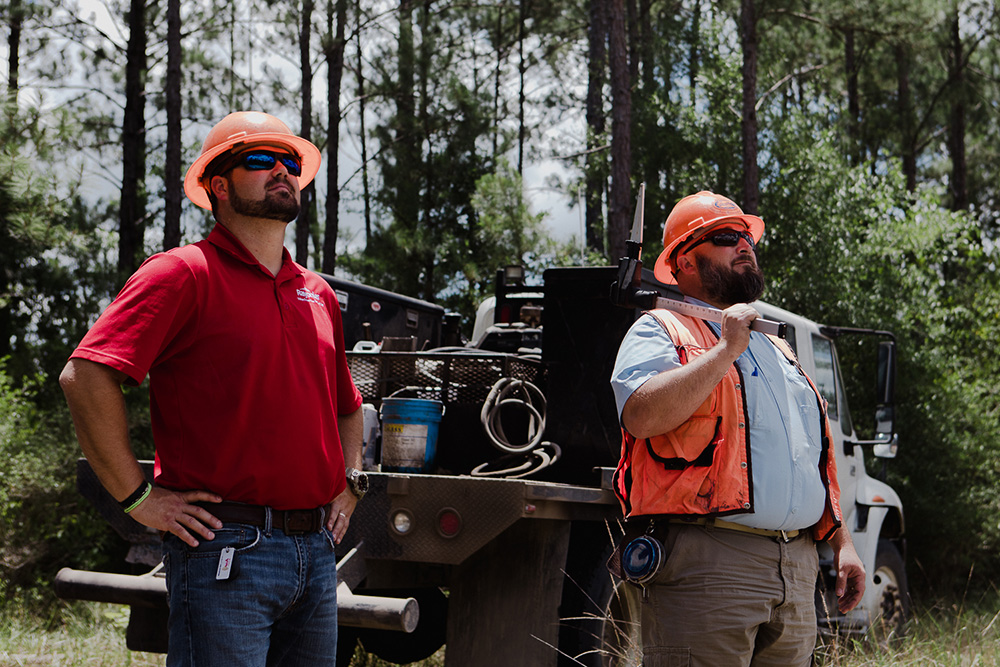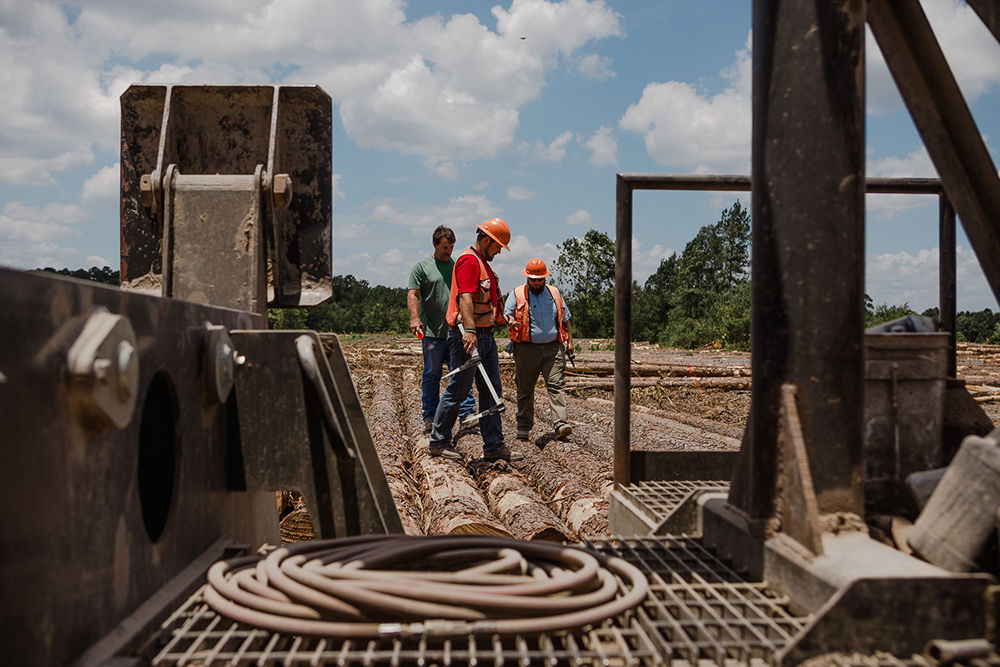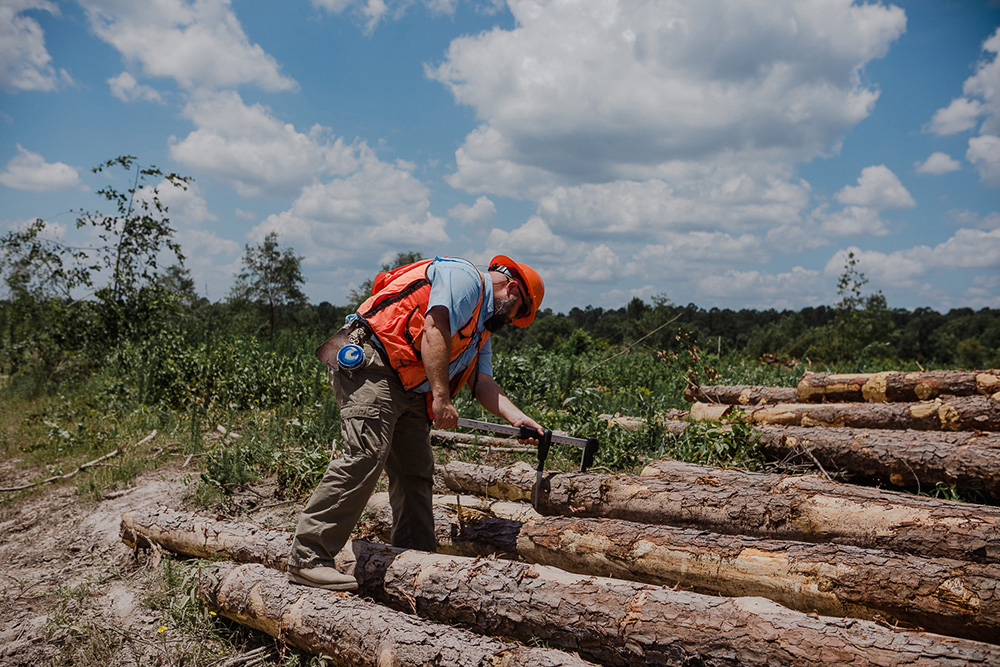Utility poles are so tall, straight and sturdy, it takes a special tree to make them. You can’t simply grow an entire forest of poles: you have to find the top candidates. Our foresters explain how they locate, measure and prepare these valuable trees.
LUFKIN, Texas—Did you ever look at a towering, perfectly-straight utility pole and wonder what tree could have made such a large pole?
Some of them come from Rayonier land!
The most valuable trees on our land in the U.S. South, “pole” trees can become utility poles for telephone and power lines or piles for docks and piers.
“It Starts with Genetics”
Pine trees in a natural forest typically do not provide a large number of poles, explains Rayonier’s Lufkin-based senior timber marketing manager, Jeremy Flood. But our in-house genetic research team has worked to develop seed families that produce tall, straight trees with smaller branches.
“It starts with genetics,” Jeremy says, “followed by decades of management with proper thinning and fertilization. The result is mature plantations with high quality grade timber.”

Finding the Right Trees for Poles
Even though the trees in a stand of timber are the same age and species, they still mature to a variety of shapes and sizes. A forest manager ensures each tree reaches its highest potential use. Trees worthy of becoming poles are the rarest—and, consequently, the most valuable—because of the very specific requirements that must be met in order to qualify.
Without careful planning and attention to detail, one could overlook these valuable trees, selling them as sawtimber, a significantly less valuable product. Jeremy’s team created a plan to ensure as many trees as possible became poles.
“It Would Be a Waste Not to Capture Their Full Potential”
“These stands have been nurtured and grown for more than 25 years. It would be a waste to not capture their full potential,” says timber marketing manager Shane Bergman, who spearheaded the project.
To locate potential poles before a harvest, a forest technician takes an inventory, statistically measuring the stand of trees to locate those that meet the size specifications needed for poles. Our foresters work closely with a logging contractor, who cuts them down, separates them from the other trees, and places them to the side for the next step.

Strict Specifications for a Log to Become a Pole
Once the poles are laying side-by-side in a giant row, a forester inspects them one-by-one. He measures them to ensure they’re straight, with an even thickness and free of defects like scars and knots that could penetrate the wood. They also have to be the right diameter for the customer’s needs.
“Poles have very tight specifications required by the customer and consumer,” Jeremy explains. “It’s not all cosmetic, much of the specs are required for engineering purposes, to ensure strength and longevity.”
They reject, or “cull,” logs that don’t meet the rigorous standards and use them for sawtimber. Using a chainsaw, they manually cut those that meet the standards to the exact size specifications of the buyer.

The logger delivers the logs to a pole mill to be processed into the final product.
Shane couldn’t be happier with the way the project worked out.
“It’s exciting to scale poles because of the relationships you build,” he says. “As you work with the contractors you get to learn about them and see that they have the same values as Rayonier when it comes to being a good steward of the forest. We truly get to work with some great individuals.”





Join the Conversation
Question. I have red pines and some white on my 7 acre property in northern Minnesota near Detroit lakes, Minnesota. These pines are approximately 80 feet tall.
I find people will cut them down for a fee, or take them for pay. These trees are 80 years old or older I’m told. I only want to thin the land, and create an opening for a road and building. I feel these trees are worthy of more than fire wood. They beautiful and could be used for log homes etc. Not looking to get rich but I thought a reasonable sum for them is fair. I’d like to see the trees get used for something useful. Are they worth anything for a better use than fire? Thank you for your time.
Hi Mark. There are a lot of factors that go into the value of a tree, so it would help to have a forestry professional take a look at the specific trees on your land. There are some great resources that can help you connect with someone with the right expertise. Most counties in the U.S. have agricultural extension offices run by state universities, which are a great place to start. Other resources that may be able to help would be your state forestry service or the state forestry association.
I am Based in Guyana, south america and we make utility poles of varying lengths from Wallaba trees.
Very interesting! So your utility poles must all have a red hue to them.
How long do the poles have to be and what diameter? I have 400 80 yr old red pine that appear to make good poles in Indiana.
Hi Mark! It would depend on the specific needs of the nearest pole mill to your property. A local extension office or forestry association can give you guidance on how to find the best use and potential buyers for your pines.
One 90ft very straight and tall pine uprooted and fell . Looks way too straight and tall to chop up for fire wood. Though only one tree , who can we call to
evaluate usage? Thanks.
Hi Rae! I would start with your local extension office. They’re offered in every county in the U.S. through local universities, and they offer all kinds of agricultural and landscaping advice, and will often come to your property to take a look. Good luck!